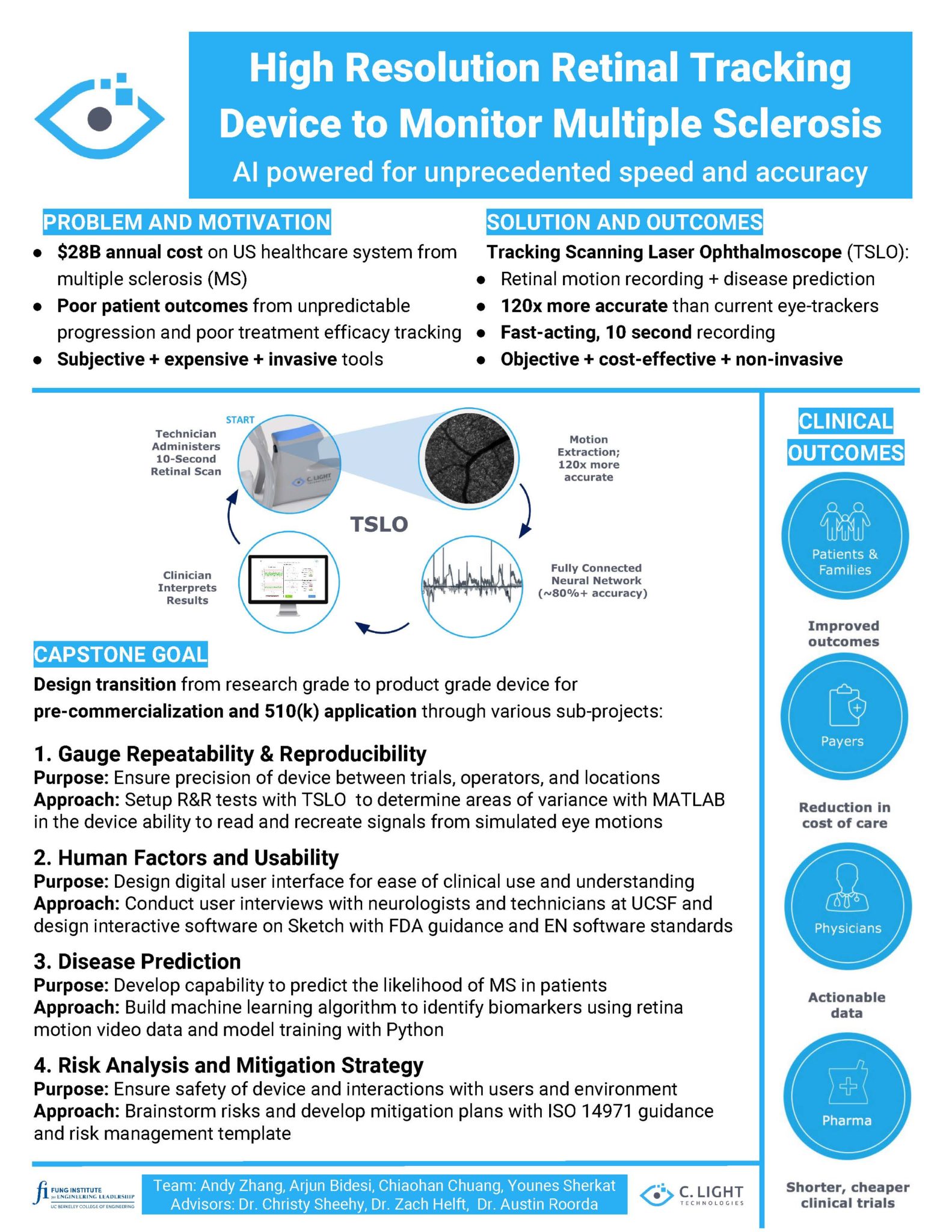AI-powered eye tracking technology with unprecedented speed and accuracy
Team: Andy Zhang (BIOE), Arjun Bidesi (IEOR), Chiaohan Chuang (BIOE), Younes Sherkat (BIOE)
Advisors: Christy Sheehy (C. Light Technologies), Zach Helft (C. Light Technologies), and Austin Roorda (UC Optometry)
The burden of multiple sclerosis (MS) costs the US healthcare system upwards of $28B annually. Delayed MS diagnoses and unpredictable disease progression create poor patient outcomes and inefficiencies across the healthcare system. There is a lack of objective, cost-effective, and non-invasive tools capable of monitoring disease progression and tracking treatment efficacy. Our industry partner, C. Light, is building an instrument that extracts eye motion over 120x more accurately than current devices on the market and uses disease prediction algorithms to efficiently, objectively, and non-invasively aid in the prognosis and monitoring of MS. C. Light will provide value throughout the care chain of MS: better outcomes and peace-of-mind for patients, treatment feedback and revenue for physicians, reduced overall healthcare costs for payers, and fast, objective outcomes measurements for therapeutic developers
Problem and Motivation
- $28B annual cost on US healthcare system from multiple sclerosis (MS)
- Poor patient outcomes from unpredictable progression and poor treatment efficacy tracking
- Subjective + expensive + invasive tools
Solutions and Outcomes
- Tracking Scanning Laser Ophthalmoscope (TSLO):
- Retinal motion recording + disease prediction
- 120x more accurate than current eye-trackers
- Fast-acting, 10 second recording
- Objective + cost-effective + non-invasive
Capstone Goal
Design transition from research grade to product grade device for pre-commercialization and 510(k) application through various sub-projects:
- Gauge Repeatability & Reproducibility
Purpose: Ensure precision of device between trials, operators, and locations
Approach: Setup R&R tests with TSLO to determine areas of variance with MATLAB in the device ability to read and recreate signals from simulated eye motions - Human Factors and Usability
Purpose: Design digital user interface for ease of clinical use and understanding
Approach: Conduct user interviews with neurologists and technicians at UCSF and design interactive software on Sketch with FDA guidance and EN software standards - Disease Prediction
Purpose: Develop capability to predict the likelihood of MS in patients
Approach: Build machine learning algorithm to identify biomarkers using retina motion video data and model training with Python - Risk Analysis and Mitigation Strategy
Purpose: Ensure safety of device and interactions with users and environment
Approach: Brainstorm risks and develop mitigation plans with ISO 14971 guidance and risk management template
Clinical Outcomes
- Improved outcomes for patients and families
- Reduction in the cost of care for payers
- Actionable data for physicians
- Shorter, cheaper clinical trials for pharma

← View all Capstone Projects





